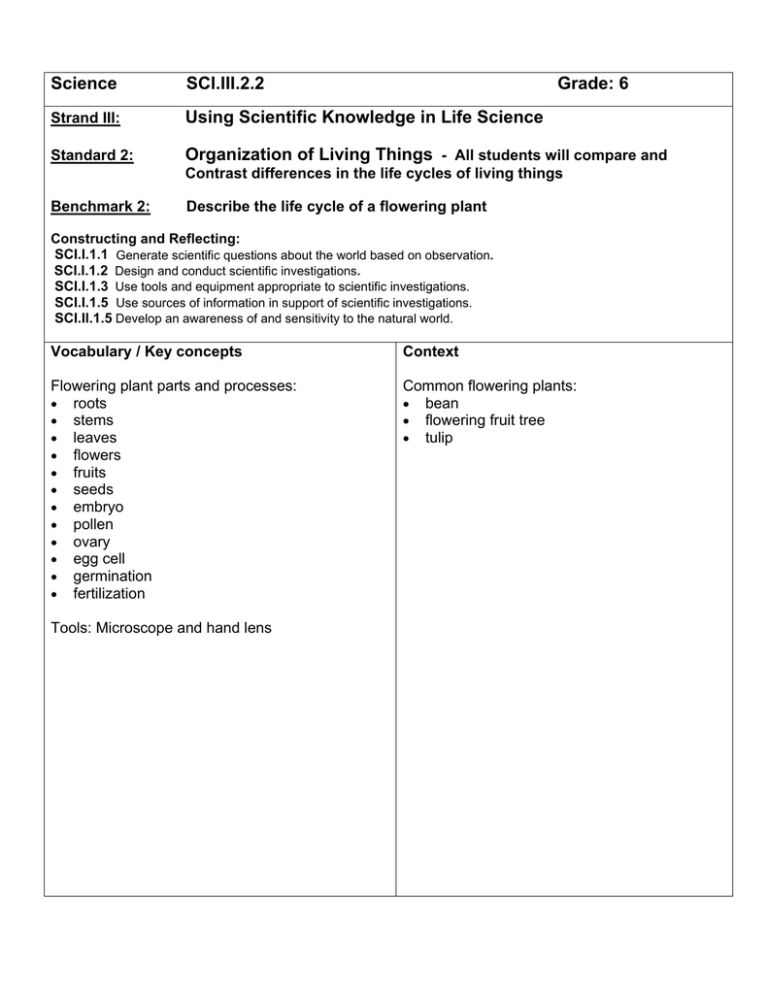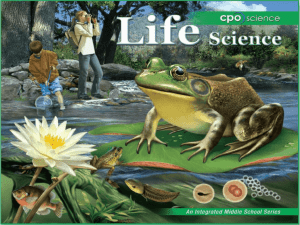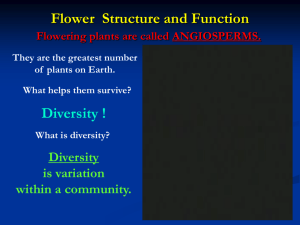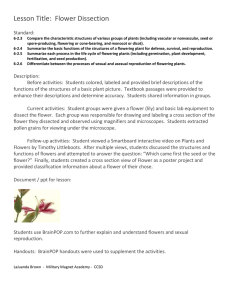Science SCI.III.2.2 Grade: 6
advertisement

Science SCI.III.2.2 Grade: 6 Strand III: Using Scientific Knowledge in Life Science Standard 2: Organization of Living Things - All students will compare and Contrast differences in the life cycles of living things Benchmark 2: Describe the life cycle of a flowering plant Constructing and Reflecting: SCI.I.1.1 Generate scientific questions about the world based on observation. SCI.I.1.2 Design and conduct scientific investigations. SCI.I.1.3 Use tools and equipment appropriate to scientific investigations. SCI.I.1.5 Use sources of information in support of scientific investigations. SCI.II.1.5 Develop an awareness of and sensitivity to the natural world. Vocabulary / Key concepts Context Flowering plant parts and processes: • roots • stems • leaves • flowers • fruits • seeds • embryo • pollen • ovary • egg cell • germination • fertilization Common flowering plants: • bean • flowering fruit tree • tulip Tools: Microscope and hand lens Knowledge and Skills Flowering plants, just like animals, have distinct stages in their life cycle. • Fertilization, the first stage of a flowering plant, involves the union of egg and sperm. Students will investigate a variety of flowers to locate the structure where sex cells form. • Next, students will recognize the stages of growth from seed to mature plant. Seeds, which contain the embryos and their food, form in the ovary as a result of the egg/sperm union. As the seeds mature and the fruit ripens, the seeds may be dispersed. • If conditions are favorable, then the seed germinates (seed coat cracks open and embryonic plant emerges) and a mature plant develops with roots, stems, leaves and flowers. • The cycle of the flowering plant is ready to begin again. Resources Coloma Resources: Laser Disk (full size) Diversity of Life CO2 & O2 Meter Using Logger Pro 3.3 Other Resources: • Michigan Soybean Promotion Committee (free classroom kit) P.O. Box 287 Frankenmuth, MI 48734 • The Lives of Plants – MDE • Wisconsin Fast Plants – University of Wisconsin-Madison • Budding Botanist – AIMS – p. 49 “Flower Study” • GrowLab – National Gardening Association – p. 118-138 “Plants from Seeds” • The Franklin Institute Online – Living Things Excellent! resource • Plant Unit – University of Tennessee • Local orchards, greenhouses and florists Videoconferences Available For more information, see www.remc11.k12.mi.us/dl or call Janine Lim 471-7725x101 or email jlim@remc11.k12.mi.us III.2.MS.2 A Seed Grows from Minnetrista Cultural Center & Oakhurst Gardens 6th Grade Science Curriculum Technology Resources III.2.MS.2 Describe the life cycle of a flowering plant Instruction Students will: • Dissect a variety of flowers to observe their structures. Dissection should be done carefully and sequentially, so structural parts are kept together. Place a sheet of black construction paper on a table and gently tap the flower to collect pollen on the paper. Examine the pollen under the microscope. Remove the petals and sepals to allow for closer observation. Examine the pollen producing structures (stamens) and remove them carefully. Observe the remaining ovary structure. Carefully slice the ovary vertically in half. Because this is a mature flower, fertilization has already taken place -- meaning that the egg and sperm have already united, forming the tiny seeds they may see. • Discuss the role the flower plays in the life cycle of a plant. • Examine a variety of seeds, such as a lima bean, to observe the embryonic plants inside. Hypothesize which areas will develop into the roots, stem(s) and leaves. • Have the students design an investigation to observe the life cycle of a flowering plant (ex. Wisconsin Fast Plants, bean plants, etc.). Self-Evaluation Checklist for the Investigation 1. Problem • Have you clearly stated the problem you investigated? • What variables did you investigate? 2. Experiment • Are your instructions for each step written clearly and completely enough so that someone else could easily replicate your investigation? • • • • • 3. Results Are your data organized in a table, chart, or graph? Are your tables, charts, or graphs properly labeled? 4. Conclusions Are your conclusions fully supported by your data? How valid are your conclusions or results? In what specific ways could your experiment be improved? Assessment Required Coloma Assessment: What are two important functions of flowers to the life cycle of plants? a. They attract bees and other animals that help move the pollen. b. They include the parts of the plant that are needed for reproduction. c. They provide beauty to landscapes and houses. d. They are an important food source for many animals. What happens to the ovary of a plant after it is fertilized? a. It falls to the ground where it germinates into a new plant. b. It takes in sunlight and carbon dioxide to produce the plant’s food. c. It grows into a fruit, which contains the plant’s seeds. d. It moves water from the roots to the leaves. Students will create a model (PowerPoint presentation, flip-book, flowchart, picture book, song, poem) illustrating the development of a flowering plant . ( seed —> plant —> flower [ fertilization / fruit development ] —> cycling back to seed ). (Give students rubric before activity.) Scoring Rubric Criteria: Correctness of plant development sequence: Apprentice - Shows inaccurate sequence of developmental stages of a flowering plant. Basic - Illustrates partial sequence of developmental stages of a flowering plant. Meets - Illustrates proper sequence of developmental stages of a flowering plant. Exceeds -Illustrates detailed examples of numerous flowering plants moving through their developmental stages. Teacher Notes: “Animals and plants have a great variety of body plans and internal structures that contribute to their being able to make or find food and reproduce. Similarities among organisms are found in internal anatomical features, which can be used to infer the degree of relatedness among organisms. In classifying organisms, biologists consider details of internal and external structures to be more important than behavior or general appearance.” (BSL) The middle school classification benchmark does not require students to be able to name or classify organisms into the major kingdoms, or to explain the difference between plant and animal cells. These two ideas are included in the corresponding high school benchmark (III.2.HS.1). Students are not responsible for knowing the difference between bacteria and viruses, or among various types of single-celled organisms: The organisms listed in the real-world contexts are only examples to be used in instruction, not organisms that students must commit to memory. (JCISD)





